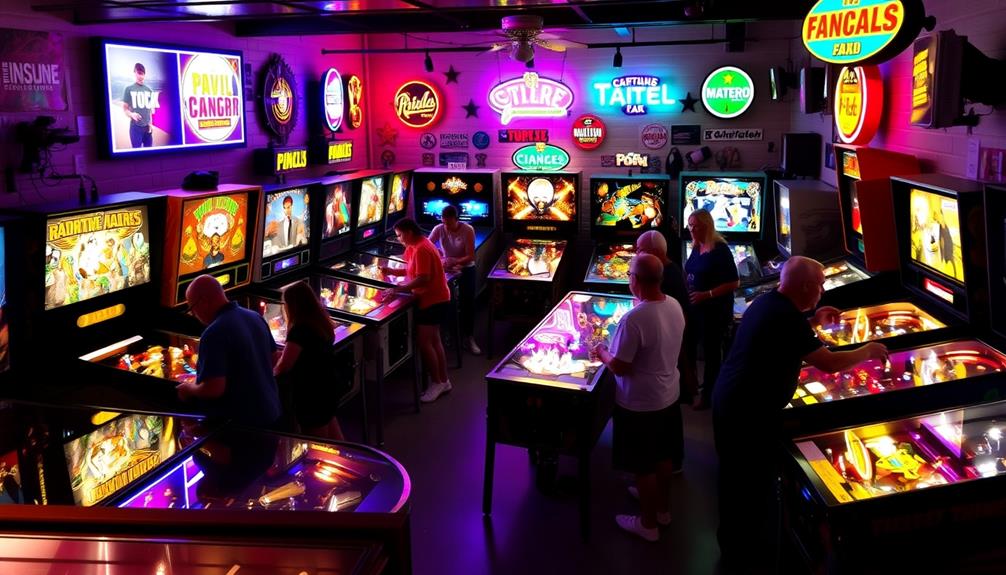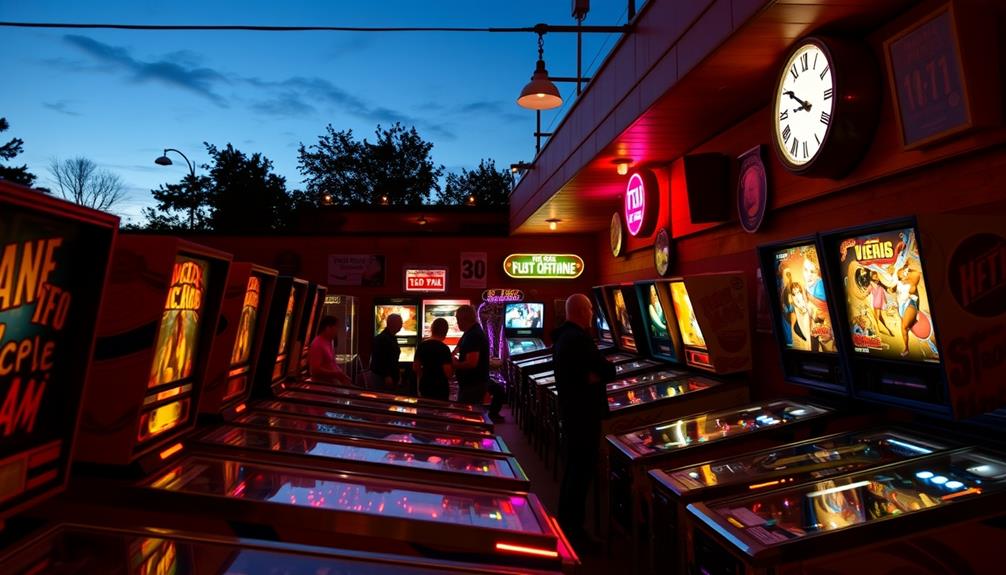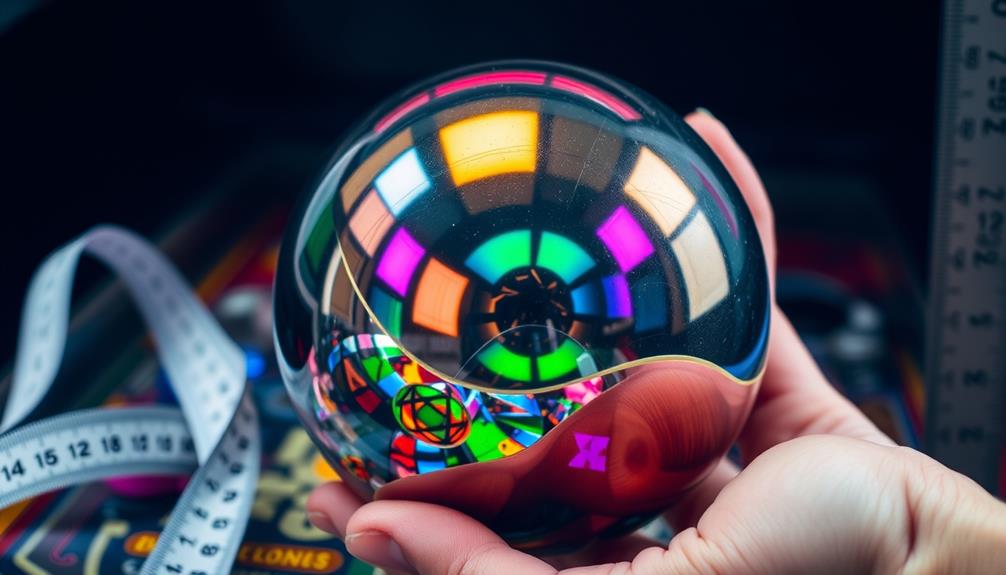A standard pinball machine typically has a width ranging from 28.5 to 29 inches. If you are thinking about adding one to your home or arcade, it is crucial to consider the space required. Wide-body machines can be a bit wider, up to 31 inches. Make sure to leave at least 75 cm between machines for easy movement and gameplay. These measurements ensure that players can comfortably interact without feeling cramped. Understanding the width is also beneficial for transporting the machine through doorways. If you are interested in learning more about pinball machine dimensions or transportation tips, you may want to explore additional insights.
Key Takeaways
- Standard pinball machines typically measure approximately 28.5 inches (72 cm) in width.
- Widebody machines are generally about 29 inches (74 cm) but can exceed 31 inches (78.7 cm).
- Maintain at least 75 cm (29.5 inches) spacing between machines for player navigation and comfort.
- Accurate width measurements are crucial for transport, fitting through doorways, and ensuring stability.
- Historical dimensions have evolved, with modern models favoring wider cabinets for advanced technology.
Overview of Pinball Machines
Pinball machines are commonly found in arcades and entertainment venues, enchanting players with their vibrant designs and engaging gameplay. These machines typically feature a cabinet width of 22 inches (56 cm) for standard models, making them compact enough for a variety of arcade settings.
The history of pinball machines highlights their evolution from simple designs to complex gameplay features, with innovations such as electronic scoring introduced in the 1970s technological advancements in pinball. You'll notice that widebody machines, designed for a more immersive experience, can reach a width of up to 29 inches (74 cm) at the top of the backbox.
This standardization in dimensions helps maintain consistency across different models, allowing for easier repairs and part replacements. When set up in an arcade, it's essential to leave at least 75 cm of space between multiple pinball machines. This guarantees you and other players can navigate comfortably without bumping into each other or the machines.
The overall width can vary slightly depending on the machine's configuration, but understanding these dimensions can help you appreciate the design and functionality of pinball machines.
Whether you're playing a classic or a modern widebody model, knowing the cabinet width enhances your experience in the thrilling world of pinball.
Standard Pinball Machine Width

Most standard pinball machines have a width of 29 inches (73.7 cm), making them easy to fit into various arcade setups. This standard width remains consistent, whether the machine has its legs on or the backbox folded down. Knowing the dimensions is essential for selecting the right machine, especially when considering best arcade machines for home game rooms.
Here are some key points about the standard width of pinball machines:
- Legs On: The width is 29 inches (73.7 cm) when the legs are attached.
- Backbox Folded: Folding down the backbox doesn't change the width; it stays at 29 inches (73.7 cm).
- No Legs: Even without legs and with the backbox folded, the width remains the same.
- Wide Body Consideration: While wide body pinball machines typically also maintain this standard width, some may be slightly wider.
This consistent width allows for easier transportation and setup in homes and arcade environments.
Whether you're a collector or just a fan, knowing the standard width of a pinball machine helps you plan your space effectively.
Wide Body Pinball Machine Width
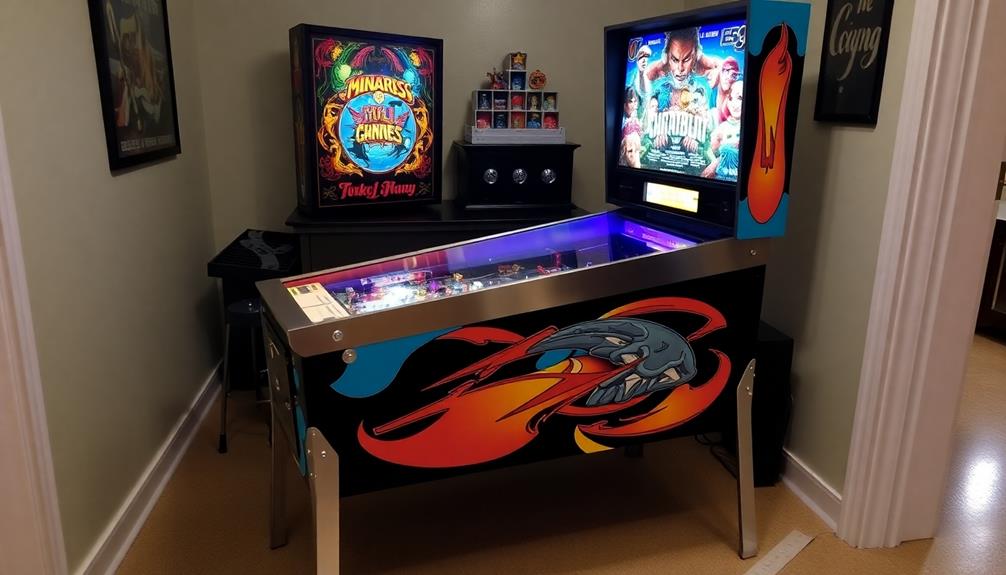
Wide body pinball machines stand out with a width of 29 inches (74 cm), which allows for a more spacious playing field and an enhanced gameplay experience. This extra half inch compared to standard machines, which measure 28.5 inches (72 cm), makes a significant difference in how you interact with the game.
As noted in best rated pinball machines, enthusiasts appreciate the intricate designs enabled by this additional space. Whether you're in a home game room or a bustling video arcade, the wide body pinball machine width contributes to a more immersive environment.
Not only does the increased width provide a larger playing field, but it also accommodates more intricate designs and features. You'll notice the additional space allows for more complex layouts, ramps, and targets, enhancing the overall excitement.
Keep in mind that wide body machines are heavier, typically weighing between 285-350 lbs (129-159 kg). This weight might make them a bit challenging to move, but it also adds stability during gameplay.
Dimensions Variations

When considering the dimensions of pinball machines, it's important to recognize that not all models are created equal.
While you may think all pinball machines are the same size, there are notable variations, especially between standard and wide body models.
Understanding common financial terms can also help when budgeting for a new machine or planning its placement in your home.
Here are some key differences to keep in mind:
- Standard Width: A typical pinball machine measures 28.5 inches (72 cm) wide, including the legs and backbox.
- Wide Body Width: Wide body pinball machines are slightly wider, coming in at about 29 inches (74 cm).
- Cabinet Width: The cabinet width for standard machines is generally 22 inches (56 cm), while wide body versions are around 23 inches (58 cm).
- Backbox Folded: When the backbox is folded down, both standard and wide body models maintain a consistent width of approximately 29 inches (74 cm).
These variations in dimensions can be influenced by specific models and their unique features.
Importance of Accurate Measurements
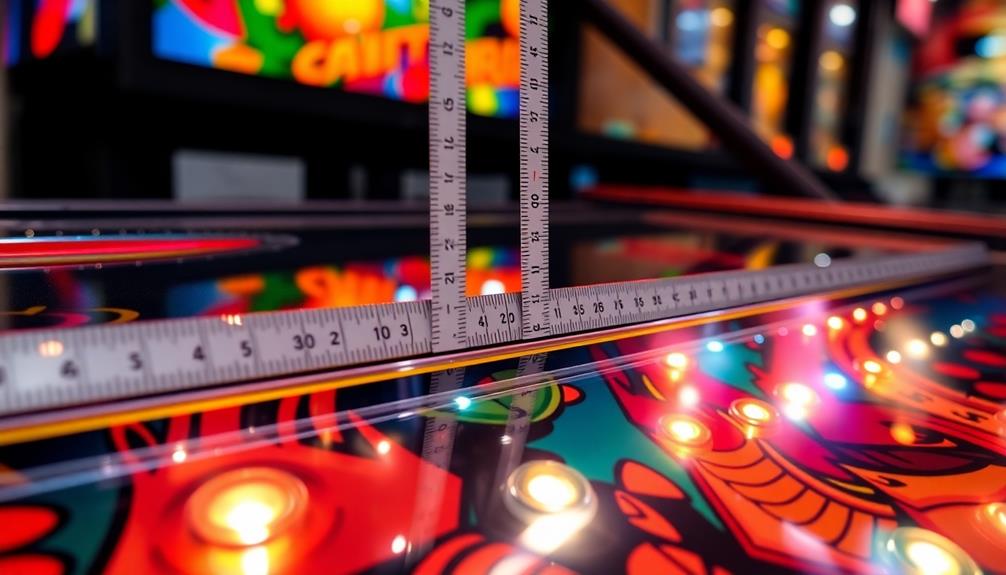
Accurate measurements are key when you're planning your game room or arcade. Knowing the width of a pinball machine not only helps you fit it through doorways but also guarantees a comfortable gameplay experience without feeling cramped.
Additionally, just like how the presence of security systems can enhance safety in a home, having the right measurements can enhance the enjoyment and accessibility of your gaming space.
If you want to enjoy the game to its fullest, take the time to measure and plan accordingly.
Precision for Space Planning
Planning your space for a pinball machine requires precise measurements to guarantee a perfect fit. Standard pinball machines typically measure 28.5 inches in width, while wide body machines are 29 inches wide. Understanding the brewing methods for coffee can help you appreciate the importance of space and comfort when enjoying your favorite beverage alongside your gaming experiences.
You need to ascertain there's enough room for maneuvering, especially in tighter spaces. Here are a few key points to contemplate:
- Allow for Space: Leave at least 75 cm (29.5 inches) between each machine to avoid crowding and guarantee accessibility.
- Mock-Up: Create a cardboard mock-up of the machine dimensions to visualize the space requirements before moving or setting it up.
- Cabinet Width: Take into account the cabinet width—56 cm for standard and 63 cm for wide body machines—to optimize your layout.
- Top of the Backbox: Measure to the top of the backbox to guarantee it fits beneath any overhead fixtures.
Impact on Gameplay Experience
Space considerations greatly impact the gameplay experience in pinball. With a standard width of about 29 inches (73.7 cm), pinball machines are designed to fit comfortably in arcade spaces. Accurate measurements guarantee that you can access the machine easily and move around without obstruction, which is vital for a smooth game.
When you're playing, having enough space to adjust your stance and interact with the flippers effectively enhances your performance and enjoyment. Additionally, just as proper spacing is important for pinball, understanding the benefits of cold medications can also improve overall health during the colder months.
If you're setting up multiple machines, remember to maintain at least 75 cm (29.5 inches) between them. This spacing not only facilitates movement but also allows players to focus on their game without distractions from others. Properly planned spacing can greatly elevate the overall player experience, making each game more enjoyable.
Understanding the dimensions helps you during transportation and installation as well. Knowing the width guarantees that machines won't get damaged when being set up, preserving the integrity of the gameplay.
Transportation Considerations

When you're getting ready to transport a pinball machine, measuring its width accurately is key to avoiding any hiccups.
It's also important to take into account the environment; for instance, maneuvering through narrow doorways or hallways may require additional planning.
Make certain you account for the weight and think about removing the legs to maneuver tight spaces more easily.
Mastering the Art of Bug Out Bags will help you reflect on how to pack efficiently.
Planning ahead will help guarantee a safe and smooth move without damaging your surroundings.
Measuring Width Accurately
Measuring accurately is essential for transporting a pinball machine effectively. You'll want to verify that it fits through doorways, hallways, and any other tight spaces. The standard width for most pinball machines is about 29 inches (73.7 cm), while widebody models typically measure around 31 inches (78.7 cm).
Understanding the importance of effective cleaning solutions can also help you maintain a tidy environment around your gaming setup.
Here are some key steps to take when measuring:
- Check the Current Configuration: Measure with the legs on or off, as this can greatly affect the width.
- Account for Protruding Parts: Don't forget to include the backbox and legs in your measurements, as they can add to the overall width.
- Use a Reliable Measuring Tool: A tape measure is ideal for getting an accurate width.
- Consider Your Transport Method: If you're using a hand truck, verify it has a wider base for added stability while maneuvering tight spaces.
Transporting Safely
After verifying you've measured your pinball machine accurately, the next step is to focus on transporting it safely. Pinball machines are fairly bulky, with standard models measuring 28.5 inches and wide body models at 29 inches in width.
To protect your investment during transport, consider the proper care guidelines for pet housing to avoid damaging the machine. You'll want to use a hand truck to maneuver it, especially when guiding through narrow stairs and tight spaces.
Strong assistance is essential during transport. The combined weight of the machine and two individuals can exceed 700 pounds, so you need to minimize the risk of injury or damage.
Before moving, make sure to remove all balls and the coin tray. This prevents internal damage and helps guarantee a smoother moving process.
Also, keep in mind the height of the machine, which can reach up to 76 inches with the backbox extended. Measure doorways and ceiling heights to verify your pinball machine fits comfortably.
Weight Considerations
Understanding the weight of your pinball machine is essential for a safe transport experience. Standard machines weigh between 250 to 300 pounds, while wide-body models can range from 285 to 350 pounds. This weight, combined with the strength of two people moving it, can easily exceed 700 pounds. Consequently, you need to plan accordingly.
Here are some key considerations for transporting your pinball machine:
- Remove All Balls and Coin Tray: This reduces weight and prevents interior damage during transport.
- Use a Hand Truck: This makes maneuvering the machine, especially up narrow stairs, much safer.
- Employ Proper Lifting Techniques: Strong assistance is necessary to avoid injury or damage to both the machine and your surroundings.
- Label Connectors: Before removing the backbox, label each connector to guarantee correct reassembly after transport.
Safety and Stability Factors

Guaranteeing safety and stability when using a pinball machine is fundamental for an enjoyable experience. The standard width of a pinball machine typically measures 28.5 inches, while wide body machines can extend to 29 inches. Wider machines often provide a more stable base, which reduces the risk of tipping or wobbling during intense gameplay. Furthermore, the construction of the cabinet and legs also play a crucial role in ensuring the safety and stability of the machine. High-quality materials and sturdy craftsmanship are essential for the most valuable pinball machines, as they are often sought after by collectors and enthusiasts. Therefore, when investing in a pinball machine, it is important to consider not only the design and features but also the build quality to guarantee a satisfying and secure gaming experience.
You should always position your pinball machine on a level surface to maintain safety and stability; if needed, use leg levelers to make adjustments.
When setting up multiple pinball machines, it's imperative to allow for proper spacing of at least 75 cm apart. This spacing not only enhances player safety but also guarantees ease of movement around the machines.
With weights ranging from 250 to 350 lbs, proper weight distribution is essential. A sturdy and stable setup prevents accidents and guarantees that players can focus on the game without worrying about potential hazards.
Historical Changes in Dimensions
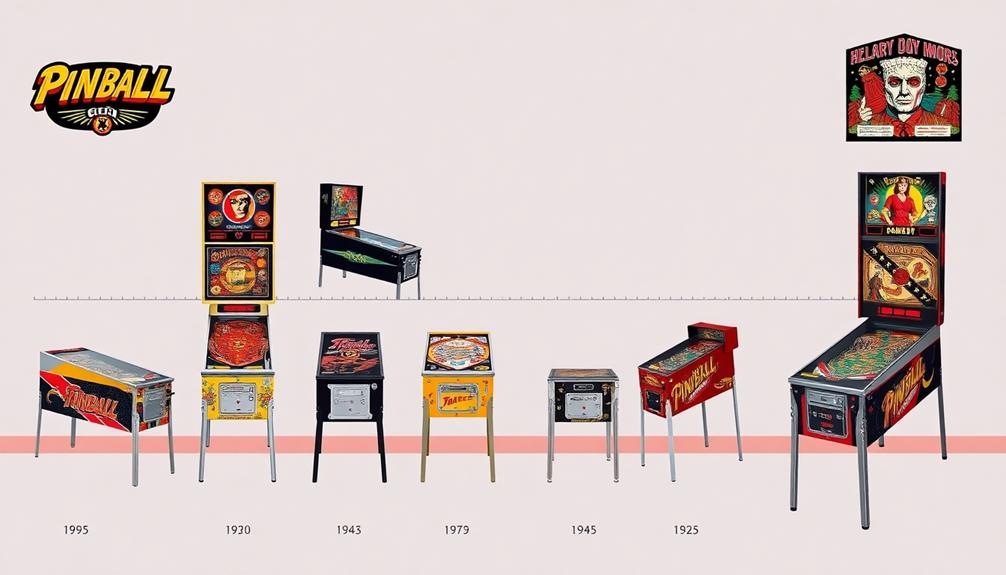
How have pinball machine dimensions changed over the decades? You'll notice that as technology advanced, so did the size of these iconic machines.
Early pinball machines, dating from the 1930s to the 1950s, were typically around 24 inches (61 cm) wide. This narrower design reflected the limitations of the era.
However, significant changes emerged in the late 1970s and early 1980s when manufacturers introduced wide-body models. These machines, measuring up to 29 inches (74 cm), offered enhanced playfield space and improved gameplay experiences.
Here's a quick look at the evolution of pinball machine widths:
- 1930s-1950s: Standard width of about 24 inches (61 cm)
- Late 1970s-1980s: Introduction of wide-body machines up to 29 inches (74 cm)
- Modern Era: Standard models now typically measure 28.5 inches (72 cm)
- Current Trends: Wider cabinets to accommodate advanced electronics and intricate designs
Today, you'll find that manufacturers like Bally and Williams have standardized these dimensions, ensuring consistency across their games.
The evolution of pinball machine sizes truly reflects the growth of technology and design in the gaming world.
Community Insights and Experiences

Community enthusiasm for pinball machines is palpable, as players and collectors share their unique experiences and insights. You'll find that understanding the dimensions of these machines can greatly enhance your enjoyment and setup.
Standard pinball machines typically measure 29 inches wide, while wide bodies also sit at 29 inches but offer different lengths and heights. This knowledge helps you navigate your space effectively.
When you're planning to place multiple machines, remember to allow for at least 75 cm (29.5 inches) between them. This spacing guarantees you and your friends can access each machine comfortably, keeping the game enjoyable and social.
Many enthusiasts emphasize how essential it's to know the width when moving a pinball machine, especially through doorways or tight spaces. Not only does this prevent damage to the machine, but it also helps avoid any frustrating mishaps during transport.
Sharing these insights within the community fosters a spirit of camaraderie among players. You'll often hear stories about unique setups or creative solutions to space constraints, illustrating the passion and dedication that pinball enthusiasts have for their beloved games.
Frequently Asked Questions
How Much Space Do I Need for a Pinball Machine?
To comfortably accommodate a pinball machine, you'll need at least 55 inches deep and 29.5 inches wide for access. Confirm you've got sufficient height and space around it for players to move freely.
How Wide Is Standard Pinball Playfield?
The standard pinball playfield width is about 20.5 inches. This design guarantees you can enjoy various features like ramps and flippers, enhancing your gameplay experience while allowing proper ball movement and interaction.
How Wide Is Widebody Pinball?
When you think about widebody pinball machines, they typically measure 29 inches wide, regardless of whether the legs are attached or the head is up. This width enhances your gameplay experience by providing more space.
What Are the Dimensions of a Folded Pinball?
Like a compact car, a folded pinball machine measures about 29 inches wide, 55 inches long, and 55 inches tall with legs. When legs are removed, its height drops to approximately 32 inches.
Conclusion
In the grand scheme of gaming, knowing the width of a pinball machine isn't just trivia; it's your ticket to a seamless experience. Whether you're eyeing a standard or a wide-body model, having accurate dimensions can save you from a tight squeeze. So, as you immerse yourself in the vibrant world of pinball, keep those measurements in mind. After all, you want your gaming space to be as inviting and fun as the machines themselves!


